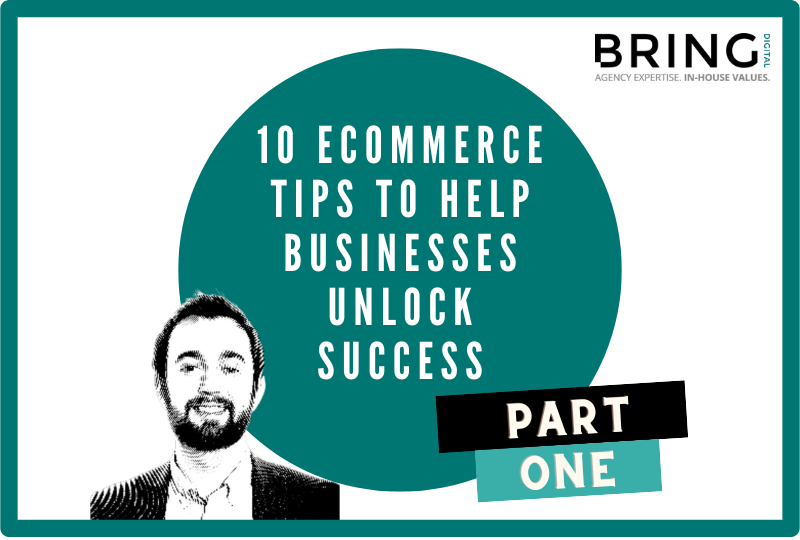
David Ingram, our founder here at Bring Digital, has picked up a few things in his years of working with some of the biggest global eCommerce brands.
We spoke to him about his key learnings navigating the digital industry. From the sleeping giant that businesses aren’t taking advantage of to how to leverage brick-and-mortar stores, he dished on his best insights that can help eCommerce businesses unlock higher profitability and growth.
Today we’re sharing his first five tips, but keep your eyes peeled for part two and the rest of David’s eCommerce lessons.
Let’s dive right in…
Now, we know what you’re thinking — but hear us out.
Many brands place a heavy focus on revenue-led KPIs as their first priority. We’re not saying that this is necessarily a bad thing, but it’s something that separates successful eCommerce businesses from the really successful ones.
“From my experience, the very best brands take a step back and see a bigger picture of acquiring long-term customer value,” explains David. Trading revenue will always be a showy metric, but optimising digital channels to acquire future customer value is what’s going to help grow your business.
When brands are defining their channel strategies; spend-vs-revenue, return on investment (ROI), and return on ad spend (ROAS) shouldn’t be the only targets that are set. The most effective way of using acquisition budget is to also ask:
These insights should be used to shape digital strategy and guide day-to-day channel trading decisions to attract the most suitable customers. It’s a case of quality over quantity; one quality customer is much more valuable than several who don’t align with a business or cost too much to retain.
“One thing I’ve seen time and time again is that foundational customer propositions will have more of an impact on eCommerce performance — in both the short and long term — than nearly anything the marketing teams can concoct,” tells David.
Customer value proposition (CVP) and unique selling proposition (USP) are very similar; they both relate to a brand’s messaging to its audience. We all know that USPs set a business apart from its competitors, but CVPs are a business’s core deliverables.
These include:
The fundamentals of marketing are to separate your business from competitors, but if these basic proposition points aren’t up to scratch with your audience’s expectations, you’re unlikely to win potential customers – or only win them begrudgingly. Neither of these outcomes will help to drive sustained growth.
“Speaking from experience, over the years at Bring Digital, there have been several occasions where our first action is to revisit the core customer proposition when creating a performance marketing strategy,” says David. “Talking proposition isn’t always as attractive as talking growth, but it’s absolutely the foundation needed before any real long-term growth can be achieved.”
Of course, this doesn’t mean that performance channel strategy should take a back seat at the expense of re-structuring your proposition. What it does mean is that even the most well-executed digital marketing strategies will struggle to fulfil their potential if these points aren’t aligned with your customers’ expectations.
“The very best eCommerce brands I’ve worked with empower their marketing teams and agencies by not only providing a best-in-class customer proposition, but by viewing it as an ongoing strategic workflow to be continually refined and improved — almost as a marketing tool in its own right.”
Affiliate marketing has seen a big change in the past decades. Amazon’s affiliate programme, Amazon Associates, was a serious factor in catapulting it into public awareness, but referral marketing was still considered a grey area.
David explains: “If I rewind 15 years to my early days in digital, affiliate marketing was dominated by low-quality publishers using somewhat questionable tactics to try and force their way into an attribution journey. Of course, there were exceptions, but generally, the channel was seen as a necessary evil for many brands. And one they were keen to move away from to focus budget and efforts into more progressive channels.”
David tells us how this all shifted for him when key advancements in the industry reframed his perception on how eCommerce brands could use affiliate marketing. These included:
“These breakthroughs mean that brands can access legions of new customers on a desirable cost-per-acquisition (CPA) basis, whilst also benefiting from a level of control and visibility that stamps out the quality problems of the past,” says David.
“Our brand partners that fully embrace affiliates and partnerships see an average of 22% of their eCommerce revenue mix come from this channel, at a lower CPA than all other paid media channels.”
“I remember the eCommerce lead of a popular high-street brand defeatedly asking how their business could compete with competition that ‘didn’t have the burden of brick-and-mortar’,” recalls David.
“There was no doubt that, commercially, their store network had challenges, but my surprise was that the eCommerce team saw this as a hindrance to their own channel performance — rather than seeing the numerous opportunities that they could leverage.”
In a world where eCommerce seems to be winning the race against in-person shopping, it can be challenging to see how physical retail locations are a viable and profitable option for businesses. Despite this, there’s one thing that physical locations have over any online store: the in-person experience factor.
Let’s delve into this and ten other quick advantages physical stores can offer eCommerce strategy:
Not all of these opportunities will be relevant to every business and the impact of some may be subtle. But, when you start to compound the effects, it does build a compelling case for how brick-and-mortar stores can provide a tangible advantage in a competitive eCommerce space.
“Offline retail does come with a whole new cost base and set of operational challenges, so this isn’t a recommendation that every web-only brand should go and open a physical location,” cautions David.
“However, this is a challenge to the omni-channel brands that believe that their store network is a competitive hindrance. It might be time to take a step back and see how your eCommerce team can use your locations as an asset that will send web-only brands green with envy.”
It goes without saying that a successful eCommerce brand should run like a well-oiled machine.
But the truth is that too many businesses are bogged down by internal blockers that are as simple as departments not working efficiently — or at all.
David shares his own experiences: “There’s a truth about inter-department collaboration that I’ve personally seen propel eCommerce brands towards market-leading growth. On the flip side, I’ve seen solid brands become unstuck when key teams are working in isolation.”
“Whilst there are countless combinations of teams that need to collaborate well together. In my experience supporting global eCommerce brands, one of the key partnerships needed to drive growth sits between the marketing and trading teams.”
Marketing teams that work in isolation from commercial teams pose three key risks to profitability:
“The most successful eCommerce brands I’ve worked with break down these barriers and ensure that trading teams are represented in marketing and growth strategy from the outset. Additionally, they make sure there’s a constant feedback loop from marketing to trade, providing insight on customer demand, trends, and behaviour.”
While removing the silos to create a more fluid workforce can typically lead to stronger performance, active collaboration between trade and marketing is what will really unlock profitable growth.
Unlocking your brand’s full potential can be difficult, especially in today’s changing landscape.
But having a read of David’s top learnings from years of industry experience can offer a fresh take on some of the issues that your eCommerce business is facing.
Let us know your thoughts below and stay tuned for the next series of lessons.











